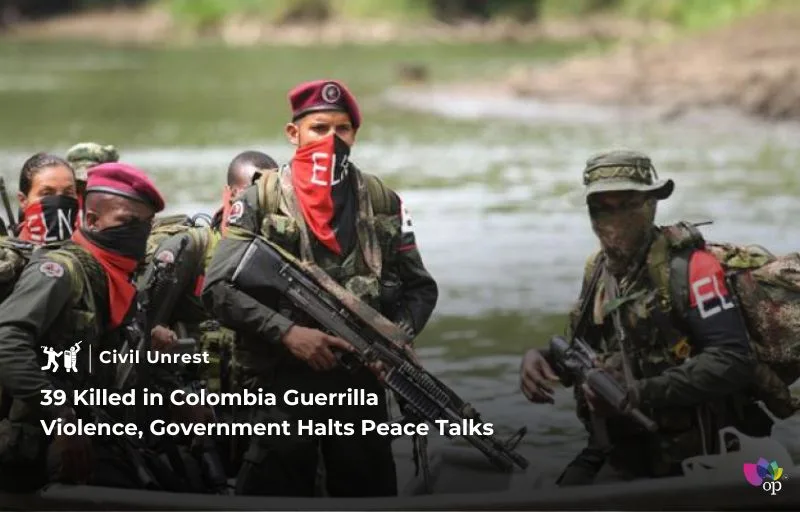Introduction
A resurgence of deadly violence by the National Liberation Army (ELN) has cast a shadow over Colombia’s fragile peace process. In the past week, the country witnessed one of the most devastating escalations in its ongoing internal conflict, with over 39 fatalities reported in separate incidents across North Santander and Bolivar departments near the Venezuelan border. The violence has prompted Colombian President Gustavo Petro to suspend peace talks with the ELN, a move that signals a critical juncture in the nation’s pursuit of “Total Peace.”
Overview of the Violence
The unrest erupted when ELN fighters engaged in attacks targeting dissident factions of the Revolutionary Armed Forces of Colombia (FARC) in North Santander. Reports indicate that ELN combatants moved from village to village, reportedly executing individuals linked to FARC dissidents, leaving at least 30 dead and over 20 injured.
Simultaneously, in Bolivar, another outbreak of violence unfolded as ELN fighters clashed with the Clan del Golfo, a criminal organization that evolved from right-wing paramilitary groups. This confrontation left nine individuals dead.
Eyewitness accounts reveal the chilling nature of the ELN’s tactics. A coca grower in North Santander shared harrowing details of how gunmen issued death threats to his community, underscoring the terror experienced by civilians caught in the crossfire. Local authorities also confirmed the displacement of dozens of families and the disappearance of over 20 individuals.
Underlying Factors
The violence is rooted in territorial disputes over lucrative coca plantations in the Colombia-Venezuela border region, a hub for cocaine production. Armed groups, including guerrillas, paramilitary factions, and cartels, have long vied for control of these areas, fueling decades of conflict. The ELN, while maintaining its ideological stance as a leftist organization, has become deeply entrenched in the drug trade, leveraging it as a primary revenue source.
Petro’s Response and Implications for Peace
President Gustavo Petro, Colombia’s first leftist leader, has championed a policy of “Total Peace,” seeking to negotiate with armed groups to end the cycle of violence. However, the latest attacks have forced him to halt negotiations with the ELN, accusing the group of committing “war crimes” and demonstrating no genuine interest in peace.
The suspension of talks marks a significant setback for Petro’s administration. His political platform hinges on achieving lasting peace, but the ELN’s aggressive maneuvers threaten to unravel these efforts. Analysts warn that the ELN appears to prioritize consolidating territorial control over engaging in dialogue, suggesting the group may be initiating a broader military campaign.
The Role of Venezuela
Complicating matters further are the ELN’s ties to Venezuela. The group’s reliance on the neighboring country as a strategic ally raises concerns about the influence of Venezuelan President Nicolás Maduro, whose strained relationship with Colombia exacerbates the geopolitical challenges. With Caracas acting as a sanctuary for ELN fighters, addressing the violence becomes increasingly complex.
Analysis: A Renewed Cycle of Conflict?
The latest escalation underscores the precariousness of Colombia’s peace efforts. The ELN’s actions reflect a strategic calculation: by consolidating control over key territories, the group strengthens its bargaining position in any future negotiations. However, this approach risks plunging the region into deeper instability.
The violence also highlights the limitations of Petro’s peace strategy. While dialogue remains a crucial tool, the absence of a robust security framework leaves communities vulnerable to armed groups. This dual approach—negotiation paired with enforcement—must be recalibrated to address the current crisis.
The involvement of external actors like Venezuela further complicates the picture. With cross-border dynamics at play, regional cooperation and international diplomacy will be essential in curbing the ELN’s influence and fostering stability.
Conclusion
Colombia’s path to peace faces a formidable challenge as the ELN’s renewed aggression threatens to derail years of progress. The government’s immediate priority must be restoring order and addressing the humanitarian fallout, including displacement and civilian casualties. In the long term, achieving “Total Peace” will require a comprehensive strategy that balances negotiation with decisive action against those perpetuating violence.
As Colombia grapples with this crisis, the stakes could not be higher—for its citizens, its government, and the broader region striving for peace and stability.
References


